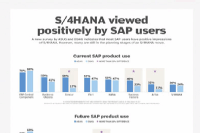

How graph technology is helping enterprises to harness the complex skill sets of...
source link: https://www.computerweekly.com/blog/Data-Matters/How-graph-technology-is-helping-enterprises-to-harness-the-complex-skill-sets-of-employees
Go to the source link to view the article. You can view the picture content, updated content and better typesetting reading experience. If the link is broken, please click the button below to view the snapshot at that time.
This is a guest blogpost by Amy Holder from Neo4j. She examines recent interest in graph databases as the basis for the next wave of human capital management technology.
Content Continues Below


Infographic: S/4HANA viewed positively by SAP Users
SAP has recognised that customers will face challenges and costs when they upgrade to S/4 Hana. It has set out a roadmap to simplify integration, in a bid to lower the transition cost of moving from ECC to the S/4 platform. This infographic shows why most SAP users have positive impressions of SAP S/4Hana.
- Corporate Email Address:
- I agree to TechTarget’s Terms of Use, Privacy Policy, and the transfer of my information to the United States for processing to provide me with relevant information as described in our Privacy Policy.
- I agree to my information being processed by TechTarget and its Partners to contact me via phone, email, or other means regarding information relevant to my professional interests. I may unsubscribe at any time.
For global HR influencer Josh Bersin, graph databases are the potential basis of a new wave of human-centric HR. What’s the rationale for this prediction—and what does it mean for the Chief Information Officer?
In his latest snapshot of the global HR technology market, Bersin and his team found that people analytics was the fastest-growing sub-domain of the HR profession, with a quarter of companies hiring into this role. People analytics means creating an HR database that reflects real day-to-day relationships and roles, not just an org chart. Bersin has identified graph technology as a promising way to realise that.
Looking at someone’s real business capabilities
Graph databases efficiently model complex networks of entities and their interrelationships, which is why they are increasingly being used to make sense of employee relationships. After all, today’s businesses need clear structures to manage reporting processes, authorisations and role allocation smoothly across the organisation. As a result, having an overview of complex organisational charts and a flexible framework to respond to structural change and people moves can be useful.
For Bersin, modern organisations are increasingly focused on role and project, which leads to the need to look at someone’s real business capabilities, not just their job title, level, or experience. As a result, complex data about employees, departments, programmes, locations, skills, career paths needs to be interrogated.
This trend is perfectly exemplified by the use of graph technology at US aeronautics and space agency NASA. Its Acting Branch Chief of People Analytics and Sr. Data Scientist David Meza explains, “As we are trying to get back to the Moon and onto Mars, we’ve to not only regenerate the skills we used to get to the Moon before but look at the new skills, and new programmes, projects and technology we have to incorporate to do that. To achieve that, we need to have a good understanding of our workforce.”
A graph-powered HR platform is meeting complex challenges
NASA built a skills analysis system to cater to its fast-changing occupations and work roles. The agency needed an HR support tool that covered core and adjacent skills, cross-functional skills, training certifications, educational credentials, and career path information, but could also capture where skills are located geographically and within which programmes and projects. Now, NASA project managers can, in real-time, contribute to succession planning and a strategic alignment model for any project to meet strategic targets.
Other large brands and first movers in using graph-based people analytics systems include car-maker Daimler and the Flemish public employment service, VDAB. At Daimler, diarising and scheduling time for project availability for its 250,000 employees in multiple locations and interdisciplinary teams worldwide can be a challenge: managers need to be able to co-ordinate leave, temporary workers, and resources from partners and service providers.
Daimler built a graph-powered HR platform to provide insight into these complex personnel structures that meets the challenges. Meanwhile, at VDAB, graph analytics empowers job seekers through a graph-based search, with the application providing citizens with useful guidance on their current skills and competencies, as well as closely matching job vacancies to a candidate’s skill set. In its next release, the graph-based system will identify skills gaps and make training recommendations.
Graph databases are about managing relationships, so there’s a definite synergy between HR and the tech. As a result, CIOs can expect it to increasingly become a mainstay for HCM vendors and large HR functions.
Amy Holder is Director, Analytics and AI Program at Neo4j. She is also co-author of Graph Algorithms:
Practical Examples in Apache Spark & Neo4j, published by O’Reilly Media
Recommend
About Joyk
Aggregate valuable and interesting links.
Joyk means Joy of geeK